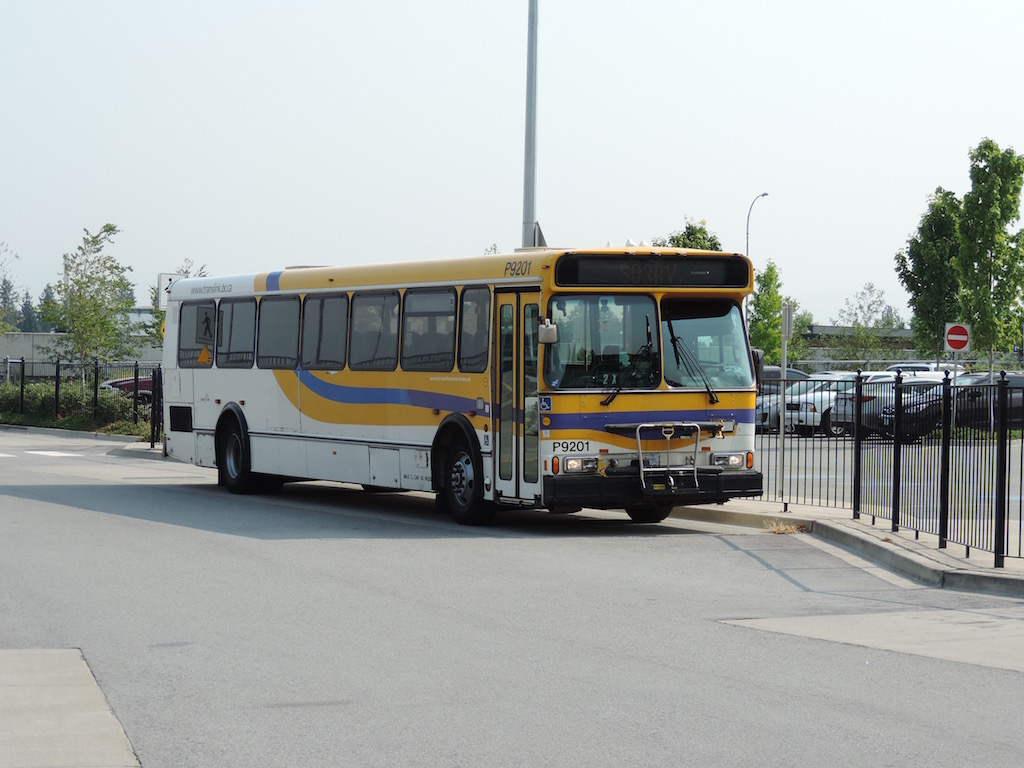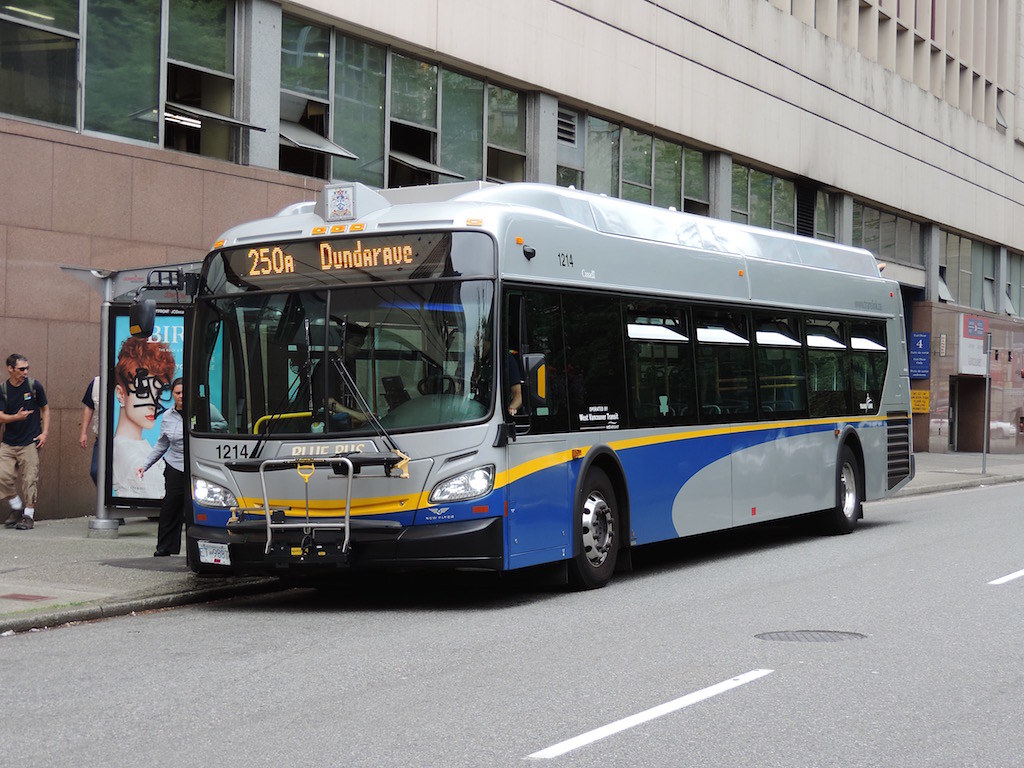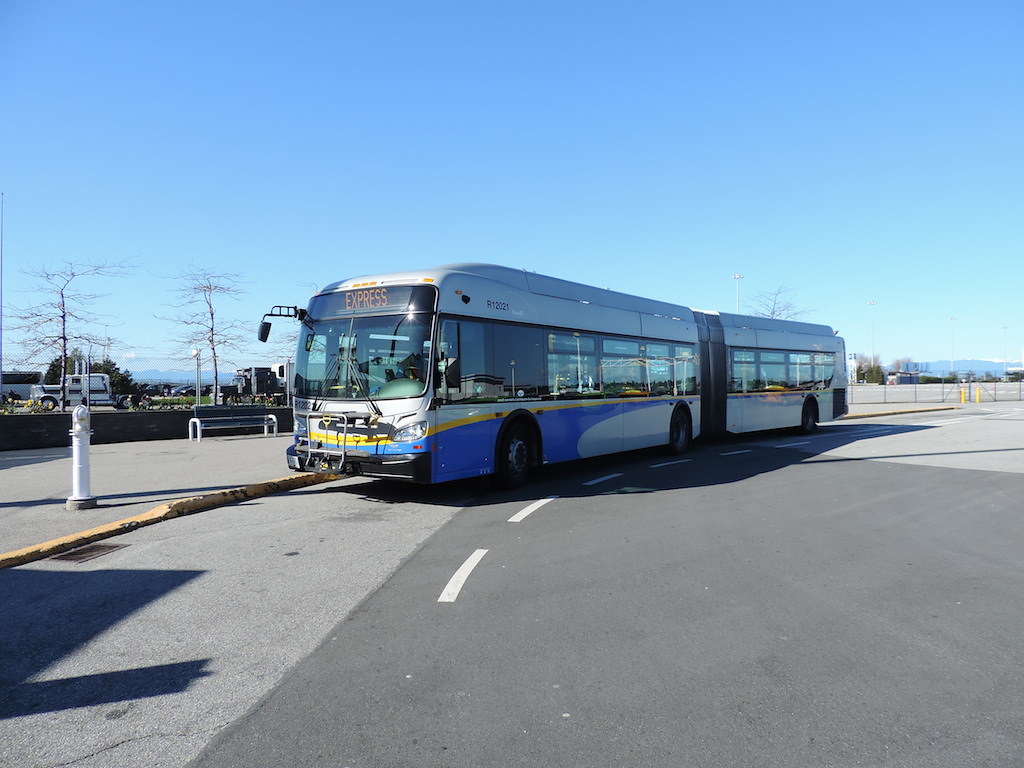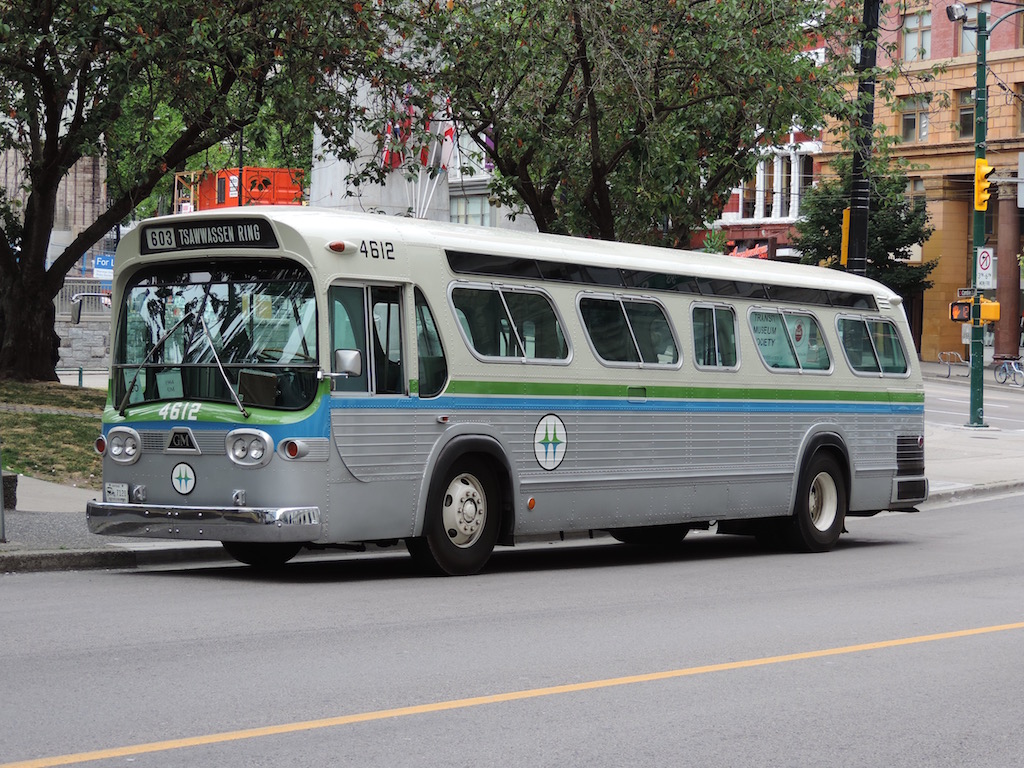|
|
Post by BreannaF on Dec 4, 2013 21:05:06 GMT -8
In a joking post this evening, Mr Sol Duc presented a photo of an articulated double decker bus. I didn't even know such a thing existed. It made me think... If one vehicle could carry such a large number of people, shouldn't we perhaps be considering it as an option against the vastly more expensive conventional LRT or Skytrain type systems? Perhaps on a dedicated roadway, or even an exclusive lane on an existing road? There is a pressing need for rapid transit along the Broadway corridor, as evidenced by the runaway success of the 99 B-Line route. Any tunnel or elevated rapid transit line along that street would present a logistical nightmare to build, as well as being horribly expensive. Perhaps these mega-buses, on a modified roadway, would present a feasible alternative, there and elsewhere. Actually, I end up commuting about once a month on the real (non-articulated) version of the bus that was used in the Photoshopped articulated double decker. The real double decker has about the same capacity as a standard artic bus, but has the advantage of not taking up as much room at the crowded bus stops in Downtown Seattle. One of the biggest issues with the Double Tall, as they are known, is that they don't let anyone go up or down the stairs while the bus is in motion, for safety reasons. So the bus is really only practical for suburban commuter routes with a few stops Downtown followed by a few stops in the outlying areas. (And the majority of ours are used where the outlying stops are at Transit Exchanges, where there is more room to take the extra time to let people on and off.) The time it would take to let someone get from upstairs to the door to get out at every stop along Vancouver's Broadway would take too long in a standard double-decker. Let alone getting someone from the back half of upstairs to the exit in the April Fool model. On something like a B-Line route, the dwell time would outweigh the extra capacity. As an aside, for anyone who might have the opportunity to get on one of the double-deckers, there's nothing like the thrill ride of sitting on the front row upstairs above the driver -- looking out the knee-to-ceiling window from above and passing just under the traffic lights and freeway signs..... |
|
|
|
Post by WettCoast on Mar 18, 2014 7:46:10 GMT -8
A special hello today to our leader & founder John H, as it is Transit Driver Appreciation Day today, March 18th. So to you, John, and all the other drivers out there, at transit systems here, there & everywhere, I say thank you & have a 'good day'. Jim, aka WCK |
|
|
|
Post by Starsteward on Mar 18, 2014 9:06:39 GMT -8
A special hello today to our leader & founder John H, as it is Transit Driver Appreciation Day today, March 18th. So to you, John, and all the other drivers out there, at transit systems here, there & everywhere, I say thank you & have a 'good day'. Jim, aka WCK
Being presently 'between vehicle ownership', I've travelled on all transit modes and must say each trip is a fascinating study in human behaviour, that ranges from pleasant, respectful and courteous to the profane end of the scale. On more than one occasion I've been tempted to indulge a 'younger-generation' rider on their behaviour, however I opt for quietly thanking my parents for instilling the type of behaviour that had I not exhibited way back when, would have gotten me a "whack upside the noggin"  |
|
|
|
Post by Mike C on Mar 18, 2014 10:31:09 GMT -8
A special hello today to our leader & founder John H, as it is Transit Driver Appreciation Day today, March 18th. So to you, John, and all the other drivers out there, at transit systems here, there & everywhere, I say thank you & have a 'good day'. Jim, aka WCK
Being presently 'between vehicle ownership', I've travelled on all transit modes and must say each trip is a fascinating study in human behaviour, that ranges from pleasant, respectful and courteous to the profane end of the scale. On more than one occasion I've been tempted to indulge a 'younger-generation' rider on their behaviour, however I opt for quietly thanking my parents for instilling the type of behaviour that had I not exhibited way back when, would have gotten me a "whack upside the noggin"  All of us who take public transit on a regular basis in Vancouver (and other metropolitan areas) know that the drivers of transit have their patience tested constantly. One must have a great deal of respect for these front-line workers - they are one of, possibly the most integral part of such a transportation system. I always try to make a point of thanking drivers when I leave the bus. |
|
|
|
Post by Scott on Mar 21, 2014 15:38:06 GMT -8
I did get one rider who wished me a happy "transit driver appreciation day"... after I gave him a free ride  Definitely is an interesting job... all the different people on the bus, and off the bus. I enjoy it most of the time. - John H |
|
SolDuc
Voyager   West Coast Cyclist
SolDuc and SOBC - Photo by Scott
West Coast Cyclist
SolDuc and SOBC - Photo by Scott
Posts: 2,055
|
Post by SolDuc on Mar 21, 2014 20:31:29 GMT -8
While I rode no bus on driver appreciation day, tonight I felt lazy and took the bus all the way up the hill just so that I could cruise down halfway to my house. The driver was really nice and greeted everyone as they came on. He also made sure to wish everyone a good day when we got off. What a nice day to end the week! As for driver stories and nice drivers, we have a local Metro driver who has a blog and contributes very good stories he has from the bus. They're always enjoyable and interesting! |
|
|
|
Post by timmyc on Mar 23, 2014 18:39:14 GMT -8
|
|
Neil
Voyager  
Posts: 7,171
|
Post by Neil on Mar 23, 2014 21:35:18 GMT -8
Don't know if we need a separate thread for this, given the obscurity of the operation, but...
I'm not surprised by its demise, and I don't really disagree with it. While I have the utmost respect for those who gave a lot of time and effort to get this streetcar up and running, it's hard to make the argument that it was ever more than a hobbyist/fan exercise. The line was very short, served little transit purpose, and had zero chance of ever being expanded. You rode it once, and that was about it. The lack of patronage spoke volumes.
Streetcar fans can take comfort in the fact that the line operated by the Fraser Valley Heritage Railway Society is back in operation this May, from their Cloverdale station. Well run, well patronized, and enjoying considerable support from the City of Surrey as well as other sources, they've had a lot more success in not only preserving old rolling stock but also in pointing out the possible future role for light rail transit- which Surrey also supports. Go for a ride this year, if you haven't already.
www.fvhrs.org/
|
|
|
|
Post by Low Light Mike on Mar 24, 2014 6:57:41 GMT -8
Don't know if we need a separate thread for this, given the obscurity of the operation Now merged into this existing thread. |
|
|
|
Post by Mike C on Mar 24, 2014 9:08:47 GMT -8
Disappointing, but not surprising.
The City of Vancouver, before the Olympics, had conceived a streetcar network for the City Center. This was supposed to be the first step towards that. Talk is cheap, and the upfront capital investment is often placed at a fairly low priority for the city's other projects (in this case, a network of on-street separated cycling lanes). During the Olympics, this line brought great value to Granville Island and False Creek South. Unfortunately, the historic aspect entails higher operating costs, and therefore not a viable contributor to the overall transit network, which is what it should be to make it successful.
I think there is great potential for a streetcar in that area, between Granville Island, Canada Line, Olympic Village, and maybe even a connection to the existing Arbutus rail line. Unfortunately, our transit authority is not in a position to fund and operate such a project, and the province has not stepped forward to properly invest in public transit. It is a shame that this is the end of the line.
|
|
|
|
Post by Blue Bus Fan on Mar 24, 2014 19:54:47 GMT -8
Disappointing, but not surprising. The City of Vancouver, before the Olympics, had conceived a streetcar network for the City Center. This was supposed to be the first step towards that. Talk is cheap, and the upfront capital investment is often placed at a fairly low priority for the city's other projects (in this case, a network of on-street separated cycling lanes). During the Olympics, this line brought great value to Granville Island and False Creek South. Unfortunately, the historic aspect entails higher operating costs, and therefore not a viable contributor to the overall transit network, which is what it should be to make it successful. I think there is great potential for a streetcar in that area, between Granville Island, Canada Line, Olympic Village, and maybe even a connection to the existing Arbutus rail line. Unfortunately, our transit authority is not in a position to fund and operate such a project, and the province has not stepped forward to properly invest in public transit. It is a shame that this is the end of the line. I think the Province should invest, a lot more on transit thought out it. I think Metro Vancouver has had more of it's share of invest in transit from the province. I think the Province should invest in light rail in Victoria and a lot more buses for BC Transit. |
|
Neil
Voyager  
Posts: 7,171
|
Post by Neil on Dec 5, 2014 23:15:02 GMT -8
A post earlier this evening by WettCoastKid, pertaining to the old Brill trolleys, made me wonder about the average lifespan of a transit bus these days.
I grew up with Brill trolleys, living near the 16 Renfrew route, and my parents not owning a car. I remember that for some reason, the oldest Brill trolleys, the 2000 series, were found on the 12 Powell and 24 Nanaimo routes- 11 Stanley Park going the other way. And I remember very clearly... well, maybe not all that clearly, that into the early '80s, after I finally smartened up and stopped driving to an evening at the pub, late nights on the 19 Kingsway were served mainly by the oldest 2000 series Brills... and when they got up to a mighty pace of fifty kilometres or so, the windows would rattle and the whole bus vibrated and sounded like it was in danger of coming apart at any moment. Of course, it might have been the six or seven pints that affected my perception.
But the oldest Brills were delivered to Vancouver in the late 1940s... and by the time they disappeared, they were 35 years old. Do any buses have that kind of longevity today? |
|
SolDuc
Voyager   West Coast Cyclist
SolDuc and SOBC - Photo by Scott
West Coast Cyclist
SolDuc and SOBC - Photo by Scott
Posts: 2,055
|
Post by SolDuc on Dec 5, 2014 23:36:08 GMT -8
A post earlier this evening by WettCoastKid, pertaining to the old Brill trolleys, made me wonder about the average lifespan of a transit bus these days.
I grew up with Brill trolleys, living near the 16 Renfrew route, and my parents not owning a car. I remember that for some reason, the oldest Brill trolleys, the 2000 series, were found on the 12 Powell and 24 Nanaimo routes- 11 Stanley Park going the other way. And I remember very clearly... well, maybe not all that clearly, that into the early '80s, after I finally smartened up and stopped driving to an evening at the pub, late nights on the 19 Kingsway were served mainly by the oldest 2000 series Brills... and when they got up to a mighty pace of fifty kilometres or so, the windows would rattle and the whole bus vibrated and sounded like it was in danger of coming apart at any moment. Of course, it might have been the six or seven pints that affected my perception.
But the oldest Brills were delivered to Vancouver in the late 1940s... and by the time they disappeared, they were 35 years old. Do any buses have that kind of longevity today? Average life for a diesel or hybrid bus is 12-15 years, and though there exist older buses out there, they're either very well maintained or the transit agency is really desperate. Trolleys tend to last longer. Here in Seattle the Breda trolleys (ex-dual mode buses) are up to 25 years old, and the Gillgs are 13 years old, though their propulsion systems date back from '79 (35 years old). Both types of coaches are at the end of their service lives and are getting replaced starting next year. |
|
|
|
Post by northwesterner on Dec 6, 2014 12:40:24 GMT -8
Average life for a diesel or hybrid bus is 12-15 years, and though there exist older buses out there, they're either very well maintained or the transit agency is really desperate. Trolleys tend to last longer. Here in Seattle the Breda trolleys (ex-dual mode buses) are up to 25 years old, and the Gillgs are 13 years old, though their propulsion systems date back from '79 (35 years old). Both types of coaches are at the end of their service lives and are getting replaced starting next year. Transit buses could run longer, like in the old days, however the Federal Transit Administration offers big capital funding grants for US transit agencies to replace their buses starting at year 12. This has incentivized agencies to eliminate heavy rebuild programs which extended the life of their coaches. Additionally, the bus manufacturers, knowing that their buses will be replaced at year 12, don't build buses with as much durability as they used to. Trolley coaches tend to last longer than diesel buses because the electric motor does not put as much strain on the body and frame as a diesel power package does. Additionally, old school electronic components seemed to last forever, especially when compared to the service life of some of those old diesel engines and highly dubious automatic transmissions. The Seattle Bredas are doing remarkably well considering their age (and the fact that they were never a good bus to begin with). They are doing better than the Gilligs, mostly because of the difficulty in procuring some of the parts for the control system (1979 printed circuit board). A friend of mine is a 32 year vet at Metro, and picks runs with Breda equipment. He mentioned to me the other day that there isn't a better performing bus in the Metro fleet and there is nothing he would rather drive instead of the Breda. |
|
Deleted
Deleted Member
Posts: 0
|
Post by Deleted on Dec 6, 2014 14:05:52 GMT -8
Here in Canada, the maximum life of a bus seems to be 17 years old. It all depends on the agency. Right now our oldest bus is built in 1998 I believe, while the Sunshine Coast still has some 1995 New Flyers. That makes sense though, seeing as Vancouver buses have a lot less down time than Sunshine Coast buses. On the Coast, the 1995's are being gradually phased out and should be gone in 2016, at 21 years old... longer than usual for diesel buses.
As for trolleys it seems like they do stick around longer. While not as long as the Brills, the New Flyer E901's lasted around 25 years.
|
|
Neil
Voyager  
Posts: 7,171
|
Post by Neil on Feb 28, 2015 18:46:22 GMT -8
Very cool photo of a Brill trolley on page S1 of today's Globe & Mail. Bathed in an eerie orange light, half buried in snow, sitting outside of the city hall of the ghost town of Sandon, BC, with a mist shrouded mountain and forested hill behind, and a figure looking out of a lit top window of the building. So incongruous. If there is bus photography art, this is it. I don't see the photo in their online edition. Worth buying the paper for the story on ghost towns.
|
|
|
|
Post by Scott on Mar 1, 2015 14:12:46 GMT -8
Very cool photo of a Brill trolley on page S1 of today's Globe & Mail. Bathed in an eerie orange light, half buried in snow, sitting outside of the city hall of the ghost town of Sandon, BC, with a mist shrouded mountain and forested hill behind, and a figure looking out of a lit top window of the building. So incongruous. If there is bus photography art, this is it. I don't see the photo in their online edition. Worth buying the paper for the story on ghost towns. www.theglobeandmail.com/news/british-columbia/breathing-life-into-into-bcs-ghost-towns/article23225716/
Not sure if they updated it since, but the above link does have photos that can be scrolled through, and that particular one is there. Thanks for pointing out this article!
- John H
|
|
Neil
Voyager  
Posts: 7,171
|
Post by Neil on Jul 31, 2015 21:05:47 GMT -8
After one of my very rare forays on transit today, I have to say I really feel for people who have to go that route in this kind of weather. And I think bus drivers should get danger pay when the temperature reaches a certain level- how do you stand the heat over several hours on one of those human microwaves?
I also forgot that the original Skytrain cars do not have air conditioning. On my way back in the evening, I waited for a 200 series train. Live and learn.
Do any of the metro Vancouver transit buses have air conditioning, and if so, what percentage of coaches would they account for? |
|
|
|
Post by Mike C on Jul 31, 2015 21:28:51 GMT -8
After one of my very rare forays on transit today, I have to say I really feel for people who have to go that route in this kind of weather. And I think bus drivers should get danger pay when the temperature reaches a certain level- how do you stand the heat over several hours on one of those human microwaves?
I also forgot that the original Skytrain cars do not have air conditioning. On my way back in the evening, I waited for a 200 series train. Live and learn.
Do any of the metro Vancouver transit buses have air conditioning, and if so, what percentage of coaches would they account for? TransLink has, with great reluctance and in no particular rush, been slowly implementing air conditioning on its conventional and community shuttle buses. All new bus orders (save for the 2001 and 2008 intercity buses which have always had them) are getting air conditioning now, and have been since 2012. This means that the last order of buses to not have it is 2009, meaning that we should be a fully air conditioned fleet as of sometime in 2030. Hope you held on to your ice pack, you might need it for a little longer  As for a percentage of the fleet, I am going to hazard a guess at less than 10% of the total conventional/community shuttle fleet possesses these cooling abilities. These buses are only operating in the Tri-Cities, Richmond, and a small handful in Surrey (only the yellow intercity buses) at the moment. Often riders wonder "is this just TransLink?" The answer is yes, for the most part, it is. By contrast, BC Transit, the provincial transit agency for every transit system outside of Metro Vancouver, operates a fleet of nearly 100% air conditioned buses. This is indeed the case with most cities in North America. |
|
Neil
Voyager  
Posts: 7,171
|
Post by Neil on Jul 31, 2015 21:57:26 GMT -8
After one of my very rare forays on transit today, I have to say I really feel for people who have to go that route in this kind of weather. And I think bus drivers should get danger pay when the temperature reaches a certain level- how do you stand the heat over several hours on one of those human microwaves?
I also forgot that the original Skytrain cars do not have air conditioning. On my way back in the evening, I waited for a 200 series train. Live and learn.
Do any of the metro Vancouver transit buses have air conditioning, and if so, what percentage of coaches would they account for? TransLink has, with great reluctance and in no particular rush, been slowly implementing air conditioning on its conventional and community shuttle buses. All new bus orders (save for the 2001 and 2008 intercity buses which have always had them) are getting air conditioning now, and have been since 2012. This means that the last order of buses to not have it is 2009, meaning that we should be a fully air conditioned fleet as of sometime in 2030. Hope you held on to your ice pack, you might need it for a little longer  As for a percentage of the fleet, I am going to hazard a guess at less than 10% of the total conventional/community shuttle fleet possesses these cooling abilities. These buses are only operating in the Tri-Cities, Richmond, and a small handful in Surrey (only the yellow intercity buses) at the moment. Often riders wonder "is this just TransLink?" The answer is yes, for the most part, it is. By contrast, BC Transit, the provincial transit agency for every transit system outside of Metro Vancouver, operates a fleet of nearly 100% air conditioned buses. This is indeed the case with most cities in North America. I guess none of the transit movers and shakers live in the eastern suburbs. A somewhat reasonable 26 degrees at the airport can easily translate to 32 at Guildford. Buses stoop for wheelchairs, they talk about the next stop, and display the stop as well. Not to mention the computerized fare boxes. Lots of money put into all of that, but at least you're telling us that everything added to the system from now on will also have the basic creature comfort of a less than broiling temperature... not a minor issue, given the increasing certainty of climate science. |
|
|
|
Post by Blue Bus Fan on Aug 1, 2015 10:38:32 GMT -8
I know Langley has Community Shuttles with A/C. I also have photos of all buses that TransLink with A/C: I posting these photos to show what models have A/C: IC Bus AC Series all years based out Port Coquitlam:  S464 S464 by Blue Bus Fan, on Flickr ElDorado National Aerotech all years excluding the S381 based out Oakridge, Langley and West Vancouver:  S544 S544 by Blue Bus Fan, on Flickr Girardin Minibus G5, only one in the whole fleet that isn't part of HandyDART, based in Langley:  S1321 S1321 by Blue Bus Fan, on Flickr The Orion V all years based out of Richmond, Surrey and Port Coquitlam:  P9201 P9201 by Blue Bus Fan, on Flickr XD40 based out of West Vancouver:  1214 1214 by Blue Bus Fan, on Flickr XN40 could become based out Hamilton, opens in 2016, and Surrey if TransLink put CNG fuelling stations in the transit Centre. XN40 based out of Port Coquitlam:  P14018 P14018 by Blue Bus Fan, on Flickr XDE60 that are based out of Richmond:  R12021 R12021 by Blue Bus Fan, on Flickr |
|
|
|
Post by timmyc on Aug 2, 2015 16:41:49 GMT -8
Interesting that Vancouver's AC Xcelsiors still have openable windows!
|
|
|
|
Post by Blue Bus Fan on Aug 4, 2015 16:56:00 GMT -8
Interesting that Vancouver's AC Xcelsiors still have openable windows! I think that West Vancouver XD40 driver is keeping the bus off and decide to open up the windows to let the bus keep cool. The XN40 only have two windows that can open per side the first normal sized window and the back window can open. |
|
Neil
Voyager  
Posts: 7,171
|
Post by Neil on Aug 4, 2015 19:26:06 GMT -8
I think that West Vancouver XD40 is driver is keeping the bus off and decide to open up the windows. What? |
|
|
|
Post by paulvanb on May 4, 2018 16:26:52 GMT -8
For our transit fans, they may like this. As well, Rapido is coming out with an HO scale GM "fishbowl" model bus!
|
|









 Definitely is an interesting job... all the different people on the bus, and off the bus. I enjoy it most of the time.
Definitely is an interesting job... all the different people on the bus, and off the bus. I enjoy it most of the time.











